The historian T.H. Fehrenbach postulated that the unique character of Texas came from one thing which differentiated it from other trans-Mississippi states; that it was in a constant state of war for the best part of half a century and so the readiness to fight for life at a moment’s notice became ingrained. Most usually, the fight was with the Comanches, who lived for war, plunder and ransom. While the Anglo settlers occasionally took a break from fighting to farm or ranch, or take up some peaceable trade, the Comanches never did; There was no other means of advancement in their culture, save being a fearless warrior and raider. At the high noon-time of their peak, they were the lords of the southern plains, from the Arkansas River to the Balcones Escarpment, having ruthlessly pushed other tribes out – the Tonkawa, Lipan Apache, the Karankawa and others. The Comanche ranged and raided as far as they pleased, occasionally interrupted by a fragile peace treaty.
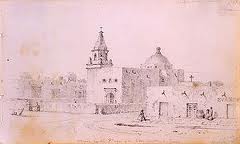 A relative period of peace between the Penateka, or southern Comanche, and the Republic of Texas came to a spectacularly violent end in the spring of 1840 during the course of what had been intended as a peace conference in San Antonio. A contingent of chiefs and Texan peace commissioners met in a large building adjoining the town jail, on Main Plaza and Market Street. In token of their good faith, the chiefs had promised – or led the Texans to believe they had been promised they would turn over a number of captives, and sign a treaty. They turned over only a few, one of them a teenaged girl, Matilda Lockhart, who had been savagely abused, raped and mutilated during a year of captivity. She told the disappointed and outraged Texan officials that the Comanches camped outside the town held more than a dozen other captives, including her own sister, but meant to extort large ransoms for each. When the chiefs and the peace commissioners met again, the commissioners asked about the other captives. The leader of the chiefs answered that they had brought in the only one they had. The others were with other tribes. And then he added, insolently, “How do you like that answer?”
A relative period of peace between the Penateka, or southern Comanche, and the Republic of Texas came to a spectacularly violent end in the spring of 1840 during the course of what had been intended as a peace conference in San Antonio. A contingent of chiefs and Texan peace commissioners met in a large building adjoining the town jail, on Main Plaza and Market Street. In token of their good faith, the chiefs had promised – or led the Texans to believe they had been promised they would turn over a number of captives, and sign a treaty. They turned over only a few, one of them a teenaged girl, Matilda Lockhart, who had been savagely abused, raped and mutilated during a year of captivity. She told the disappointed and outraged Texan officials that the Comanches camped outside the town held more than a dozen other captives, including her own sister, but meant to extort large ransoms for each. When the chiefs and the peace commissioners met again, the commissioners asked about the other captives. The leader of the chiefs answered that they had brought in the only one they had. The others were with other tribes. And then he added, insolently, “How do you like that answer?”
The short answer was the Texans did not. There were already soldiers standing by: they were ordered to surround the Council House. The chiefs were told they were held hostage until their warriors returned to their camps and brought back the rest of the hostages. Almost as one, the chiefs drew knives and rushed the soldiers guarding the doors of the Council House. The warriors waiting outside in the yard entered the fray and a short running fight erupted in the street leading down to the San Antonio River. The Council House fight vigorously re-ignited the war between Comanche and Texan, both sides accusing the other of bad faith and treachery. That fall, a huge contingent of Penateka Comanche led by a war leader named Buffalo Hump came roaring down from the Llano Estacado, sweeping down the empty country between the Guadalupe and Lavaca Rivers. They terrorized the town of Victoria and burned Linnville on Lavaca Bay. The citizens of Linnville watched from the refuge of boats offshore, as the Indians looted the warehouses and homes. Then the Penateka departed, with two hundred horses all heavily laden with plunder, but what happened on the return from that spectacular raid set in motion a gathering of forces and personalities who would eventually reduce the proud lords of the Southern Plains to a handful of desperate, starving beggars.
It was not as if the Texans were entirely defenseless; poor in cash, poor in practically everything but land, frontier Texas had attracted large numbers of the restless and adventurous, who were not inclined to accept any sort of insult lying down. With no meaningful standing army, defense of local communities depended on their militia … usually composed of every able-bodied male. The sheer size of Texas and the nature of war waged by the horse-lords of the Southern Plains made it imperative that at least a portion of the militia be mounted. Over the twenty years after the founding of Stephen Austin’s colony the practice evolved for a mounted militia, ready to ride in pursuit of raiders within fifteen minutes after an alarm being sounded. Sometimes they were able to retrieve captives, or stolen horses. More often, the raiding Indians split up and melted like smoke into the wilderness, leaving their pursuers frustrated and fuming. It became quite clear, as more Anglo settlers poured into Texas, that the best defense was in the offense; to field a mounted patrol out ranging the back-country, looking to forestall Indian raids.
Such a Corps of Rangers was formally established on the eve of Texan rebellion against Mexico. Distinct from the militia and the regular army, the mounted ranging companies continued to serve after the war, in various forms, most of them locally supported. The citizen-rangers of the local companies assembled for short periods of time in response to specific dangers, their numbers ever-flexible. They supplied their own arms, horses and equipment. By the time of the Linnville Raid, most of them were veterans of the War for Independence, and had years of experience in the field otherwise; men like Mathew “Old Paint” Caldwell of Gonzales, and the McCulloch brothers, who had handled Sam Houston’s two artillery pieces at the Battle of San Jacinto. Ben McCulloch had even been trained in outdoor skills by no less than Davy Crockett himself. In response to the sack of Linnville, volunteer companies from settlements along the Colorado assembled under Edward Burleson, including Chief Placido and twelve Tonkawa Indians, who had their own score with the Comanche to settle, and twenty-one volunteers from Port Lavaca. Other volunteers gathered from Bastrop, Cuero, Victoria and other towns scattered along the river valleys between the coast and the start of the limestone hills.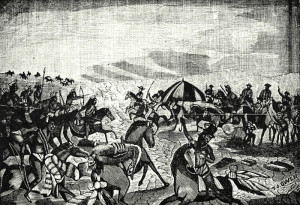
Barely a week after the burning of Linnville, companies of volunteer Texans were closing in inexorably on the withdrawing Comanche raiding party, at an open plain by Plum Creek, a tributary of the San Marcos River near present-day Lockhart. Burdened by loot, captives and a slow-moving herd of stolen horses and mules, the raiders had not split up and scattered as was their usual custom – and now they had become the hunted. Buffalo Hump’s war party were closely pursued by part of McCulloch’s Gonzales company, who began seeing exhausted pack animals shot and left by the wayside. Caldwell and the other leaders had deduced the route by which they were returning, and had arranged their forces accordingly. They let the Comanche column pass, under a great cloud of dust and ash, for the prairie had recently been burned over. Not until the Texans rode out from cover in two parallel lines converging on them, did the Comanche warriors even know they had been followed. Some of their gaudily adorned chiefs rode out to put on a show, intending to cover the withdrawal, taunting the waiting Texans, riding back and forth. A Texan sharp-shooter brought down the most flamboyant of the chiefs, and when several warriors rode out to carry his body away, the order for a charge was given. The Texans smashed through the line of Comanche fighters from both sides, and into the loot-laden horse and mule herd. As the herd stampeded, the whole raid dissolved into a rout, a hundred bloody running fights, with the Comanche fighters penned in and ridden down. The battle ran for fifteen miles, with some of the survivors chased as far as Austin. It was later estimated that the tribe lost about a quarter of their effective fighters, and much of the loot.
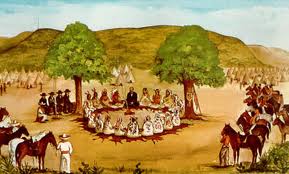 The Penateka never raided again so far into the settled lands, and fifteen years later Buffalo Hump would be one of the Penateka chiefs who signed a peace treaty with John Meusebach. That treaty lasted, although epidemics of diseases like cholera eventually reduced the Penateka. There is a monument in Fredericksburg, Texas, commemorating that treaty as one which was never broken, and in most years there is a gathering of Comanche and descendants of German settlers to commemorate the event.
The Penateka never raided again so far into the settled lands, and fifteen years later Buffalo Hump would be one of the Penateka chiefs who signed a peace treaty with John Meusebach. That treaty lasted, although epidemics of diseases like cholera eventually reduced the Penateka. There is a monument in Fredericksburg, Texas, commemorating that treaty as one which was never broken, and in most years there is a gathering of Comanche and descendants of German settlers to commemorate the event.
(A description of the treaty negotiations between John Meusebach and the Penateka is part of Adelsverein-The Gathering, and the aftermath of the Plum Creek fight is included in Deep in the Heart.)

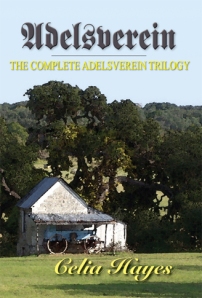
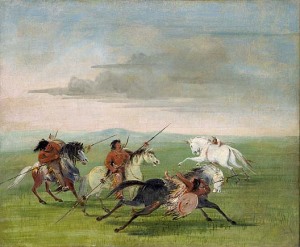
Recent Comments